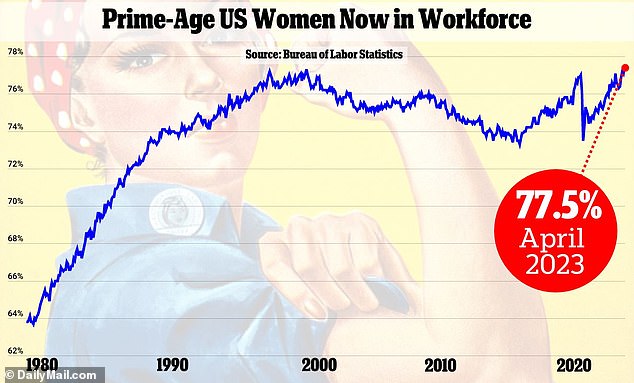America’s childcare CLIFF EDGE: More than 3 million children to lose their daycares when federal funding stops in September – and it could reverse women’s gains in the labor force
US Child Care CLIFF EDGE: More than 3 million children will lose their child care if federal funding ends in September – and this could reverse women’s gains in the labor market
- Around 3.2 million children will lose their daycare, according to a groundbreaking new report
- The pandemic-era aid that has helped child care facilities stay afloat is coming to an end
- Experts warn this could reverse the record growth of women in the workforce
More than three million children will lose their childcare places if the government pulls the plug on the pandemic era at the end of September.
Estimates from The Century Foundation (TCF) suggest that as many as 70,000 child care programs are at risk of closing if support dries up.
Experts warn the crisis could wipe out women’s gains in the labor market after the number of women in the workforce reached record highs this year.
In March 2021, President Biden signed the American Rescue Plan (ARP) Act, which set aside $24 billion to support child care centers.
Many used the money to raise staff wages to avoid looking for higher-paying jobs. It is believed to have helped more than 200,000 service providers stay afloat.
States have until the end of September to distribute the remaining funds. Researchers at the TCF say the deadline represents a ‘cliff-edge’, leaving 3.2 million children without a place to go while their parents work.
Among the hardest-hit states is Texas, which stands to lose 3,949 child care programs, affecting 305,976 children.
In New York, 5,753 programs will close, leaving $251,509 in child care costs, while 84,417 California children will also lose their places.
In Arkansas, Montana, Utah, Virginia, West Virginia and Washington DC, the number of licensed daycare centers could be halved.
The report states that these losses will have a “ripple effect for parents who are forced to stop working or reduce their working hours.” Experts added that the trend would disproportionately harm women.
Julie Kashen, director of TCF for Women’s Economic Justice, said: “As child care programs are forced to raise prices to retain staff, parents will either have to pay even more for child care, work fewer hours or be forced to leave their jobs completely.” say.
“We know the responsibilities will fall primarily on women and will harm not only their lifetime income and retirement security, but also their families’ bottom lines.”
It comes after data from the Bureau of Labor Statistics showed the number of women aged 24 to 54 in the workforce had reached a record high – after a brief dip during the pandemic.
Mother of three and licensed attorney Crystal Gamache, pictured, couldn’t find anywhere to take her children part-time in Spokane, Washington

In April, women’s labor force participation reached a record high of 77.5 percent, surpassing the 2000 peak
Many states have already become “childcare deserts” with too few facilities to serve the area’s families.
Mother of three and licensed attorney Crystal Gamache couldn’t find anywhere to take her children when she sought part-time care in Spokane, Washington.
The 34-year-old said she has relied on the help of babysitters in the past, but ultimately ended up having to pay to go to work because her childcare costs exceeded her wages.
Gamache – who has a five-year-old daughter and two sons aged three and eight months – now works as a professor at a local university where she teaches law, specializing in rights and policies affecting children. The family is supported by her husband, who works in private equity in real estate.
She told DailyMail.com: ‘Women training to be doctors and lawyers often meet their husbands during their studies and they end up in the same high tax brackets.
‘It means that these women can afford not to work and to drop out of the workplace. But this is how we lose our most brilliant female employees.”
The withdrawal of women from the workforce could worsen the labor shortage, the TCF report said.
It estimates that the disruption caused by the so-called cliff edge could cost the US $10.6 billion in tax and business revenue annually, while families would lose $9 million in income annually.
The childcare sector also disproportionately employs women – with as many as 232,000 jobs at risk if funding ends.
